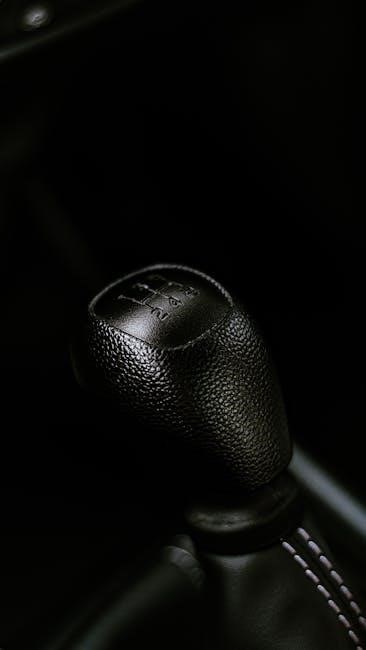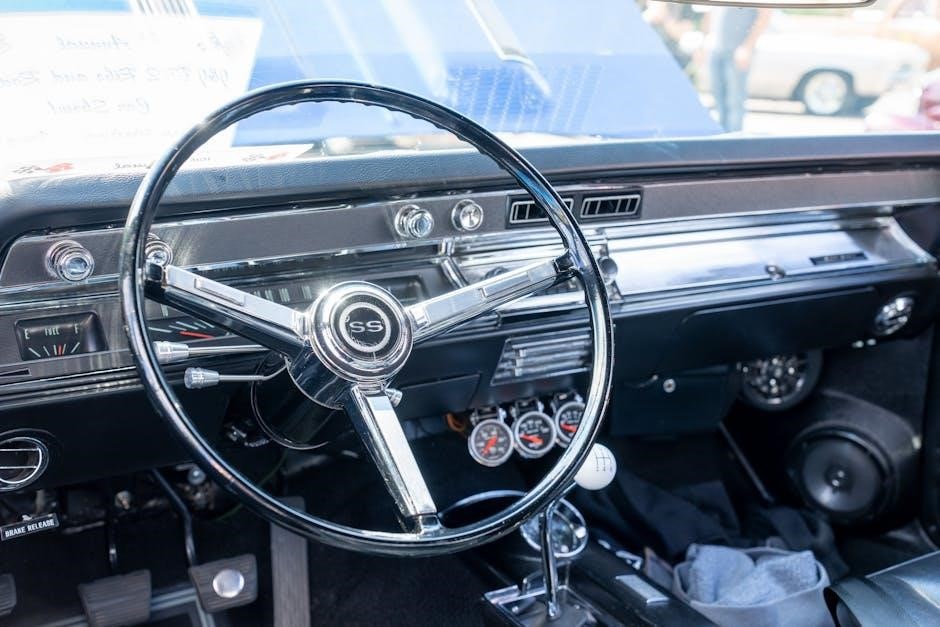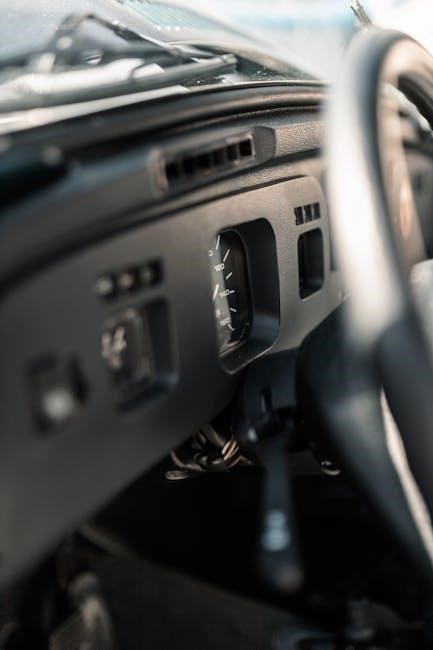Manual steering relies solely on the driver’s physical effort, converting rotational motion into directional control without external power assistance, providing a direct connection to the vehicle’s wheels.
1.1 Definition and Basics
Manual steering is a system where the driver controls the vehicle’s direction entirely through physical effort, without mechanical or hydraulic assistance. It relies on the driver’s strength to turn the steering wheel, which is directly connected to the front wheels via a mechanical linkage. The core components include the steering wheel, steering column, and gearbox, which translate the driver’s input into wheel movement. This system is straightforward, with no external power aids, making it the simplest and most direct form of steering. It offers a pure driving experience, providing immediate feedback from the road to the driver.
1.2 Historical Context
Manual steering systems date back to the early days of automotive history, with the first vehicles relying solely on mechanical linkages to control direction. The Ford Model T, introduced in 1908, famously used a manual steering system, showcasing its simplicity and effectiveness. Early drivers accustomed themselves to the physical effort required, as power steering did not become widespread until the mid-20th century. This historical context highlights manual steering’s role as the foundation of automotive control, with its evolution reflecting advancements in engineering and driver demands for greater ease and efficiency behind the wheel.
1.3 Importance of Manual Steering
Manual steering plays a crucial role in providing direct driver engagement and road feedback, enhancing the driving experience. Its simplicity ensures reliability, as fewer components mean less likelihood of mechanical failure. For enthusiasts, manual steering offers precise control and a connection to the vehicle’s handling, making it a preferred choice for sporty or vintage driving. Additionally, it serves as a fallback in cases where power steering systems fail, ensuring vehicles remain operable. This blend of practicality and performance underscores its enduring relevance in automotive design and driving culture.

Components of Manual Steering
Manual steering systems comprise the steering wheel, steering column, gearbox, rack and pinion or worm and sector mechanisms, and steering linkage, ensuring precise control.
2.1 Steering Wheel
The steering wheel is the primary interface between the driver and the vehicle, enabling directional control. Typically circular with a diameter of 360–380 mm, it is designed for comfortable grip and ergonomic handling. Modern steering wheels often feature telescoping and tilting adjustments to suit driver preferences. The rim thickness and material, such as leather or urethane, enhance grip and feedback. Some steering wheels include additional controls for functions like audio or cruise control. Its simplicity and direct connection to the steering system make it a critical component for precise vehicle maneuvering;
2.2 Steering Column
The steering column is a critical component of the manual steering system, serving as the connection between the steering wheel and the steering gearbox. It consists of a hollow shaft with universal joints, allowing for smooth transmission of rotational motion. The column is typically adjustable, offering telescoping features for driver comfort. Mounting points secure it to the vehicle’s frame, ensuring stability. The steering column also incorporates safety features, such as collapsibility during impact, to protect the driver. Its durability and precise engineering ensure consistent and reliable steering performance, making it indispensable for manual steering functionality.
2.3 Steering Gearbox
The steering gearbox plays a vital role in manual steering systems by converting the rotational motion of the steering column into directional movement for the vehicle’s wheels. It houses gears—such as spur or helical gears—that adjust the speed and torque of the steering input. Connected to the steering column, the gearbox transmits motion to the pitman arm, which engages the steering linkage to turn the wheels. The gearing ratio within the gearbox determines the steering effort required, balancing ease of turning with precision and control. Regular lubrication is essential to maintain smooth operation and prevent wear on the gears, ensuring long-term reliability and consistent steering performance.
2.4 Rack and Pinion Mechanism
The rack and pinion mechanism is a widely used manual steering system. It consists of a toothed rack and a pinion gear that meshes with it. When the steering wheel rotates, the pinion turns, moving the rack linearly. This linear motion is transferred to the wheels through tie rods, enabling precise directional control. Compact and efficient, this mechanism is favored in many vehicles for its simplicity and responsiveness. However, it can have limitations in suspension travel, which may affect articulation in off-road conditions. Regular maintenance, such as lubrication and alignment checks, ensures optimal performance and longevity of the system.
2.5 Worm and Sector Mechanism
The worm and sector mechanism is another type of manual steering system. It uses a worm gear that meshes with a sector gear attached to the steering column. As the worm rotates, it turns the sector, converting rotary motion into angular movement. This mechanism provides a mechanical advantage, reducing the effort needed to steer. It is commonly found in older vehicles and heavy-duty applications due to its durability and simplicity. However, it can be less precise compared to rack and pinion systems. Regular lubrication of the gears is essential to maintain smooth operation and prevent wear over time.
2.6 Steering Linkage
The steering linkage is a critical component that connects the steering gearbox to the vehicle’s wheels. It consists of tie rods, idler arms, and drag links, which work together to transfer the steering motion from the gearbox to the wheel hubs. The linkage ensures precise alignment and directional control, maintaining proper toe and camber settings; Regular inspection and lubrication of the joints are essential to prevent wear and ensure smooth operation. Over time, worn or loose components can lead to vague steering and reduced handling, making maintenance crucial for optimal performance and safety on the road.

Working Principle of Manual Steering
Manual steering operates through a mechanical connection, where the steering wheel’s rotation is transmitted via the steering column to a gearbox. This converts the motion into linear movement, directing the wheels precisely.
3.1 Mechanical Connection and Gear Transmission
Manual steering relies on a direct mechanical connection between the steering wheel and the vehicle’s wheels. The steering column transmits the driver’s input to a gearbox, which converts the rotational motion into a linear movement. This motion is then directed through the steering linkage to the wheels. The gearbox, often a worm-and-sector or rack-and-pinion mechanism, amplifies the steering effort while maintaining precision. This system ensures that the driver’s input is translated accurately, providing a direct feel of the road and precise control over the vehicle’s direction.
3.2 Steering Shaft and Universal Joint
The steering shaft acts as the backbone of manual steering, connecting the steering wheel to the gearbox. It is designed to withstand torsional stress while transmitting rotational force. A universal joint is often incorporated to accommodate the angle between the steering column and gearbox, ensuring smooth power transmission. This joint allows flexibility without compromising the direct mechanical connection, enabling the system to function seamlessly even when the steering wheel is turned at an angle. Together, the steering shaft and universal joint ensure precise and efficient control, maintaining the integrity of the manual steering mechanism.

Advantages of Manual Steering
Manual steering offers enhanced road feel, direct control, and better driver engagement. Its simplicity reduces maintenance and costs, while reliability ensures consistent performance without reliance on external systems;
4.1 Better Road Feel and Control
Manual steering provides a direct connection between the driver and the road, offering superior road feel and control. Unlike power steering, manual systems transmit road inputs directly to the driver, allowing for precise handling and responsiveness. This tactile feedback enhances driving engagement and enables drivers to anticipate and react to road conditions more effectively. The absence of assistive mechanisms ensures a more authentic driving experience, particularly beneficial for purists who value a connected feel behind the wheel. This direct connection improves overall vehicle control, especially during cornering or braking, making manual steering a preferred choice for drivers seeking precision and accuracy.
4.2 Simplicity and Reliability
Manual steering systems are renowned for their simplicity and reliability. With fewer components compared to power steering, these systems are less prone to mechanical failures. The absence of complex hydraulic or electric assistance reduces the likelihood of system malfunctions, making them more dependable over time. This straightforward design also leads to lower maintenance requirements, ensuring longevity and consistent performance. Drivers can rely on manual steering to deliver consistent handling without the need for additional power sources or intricate mechanisms. This simplicity enhances overall system durability and makes manual steering a preferred choice for its uncomplicated, dependable nature.

Disadvantages of Manual Steering
Manual steering requires increased driver effort, particularly at low speeds or when maneuvering tightly. This can lead to driver fatigue and is less ideal for heavy vehicles.
5.1 Higher Driver Effort
Manual steering systems lack power assistance, requiring drivers to exert more physical effort, especially at low speeds or when parking. This can lead to driver fatigue during long trips or in heavy traffic conditions. The absence of hydraulic or electric aid means the driver must rely solely on muscle strength to turn the wheels, making it less convenient compared to power steering. While this provides better road feel, it demands consistent energy input, particularly in vehicles with larger or heavier wheels. This disadvantage is most noticeable in urban driving scenarios where frequent maneuvering is required.
5.2 Limited Assist at Low Speeds
Manual steering systems do not provide any mechanical or hydraulic assistance, making low-speed maneuvers more challenging. Turning the wheels in tight spaces, such as parking lots or U-turns, requires significantly more effort and precision. This lack of assist is particularly noticeable during slow-speed driving, where the driver must rely entirely on muscle power to navigate. While this enhances road feel, it can lead to driver fatigue and difficulty in situations requiring frequent or sharp turns. The absence of power aid is a notable disadvantage in urban environments where low-speed driving is common.

Manual vs. Power Steering
Manual steering relies on driver effort for control, while power steering uses hydraulic or electric systems to reduce steering effort, enhancing comfort but reducing road feel and connection.
6.1 Key Differences
Manual steering requires physical effort from the driver, relying on mechanical connections to translate input to the wheels. Power steering, in contrast, uses hydraulic or electric assistance to reduce effort. Manual systems provide direct road feel and precision, appealing to purists, while power steering prioritizes comfort and ease, especially in larger vehicles. Manual systems are simpler, with fewer components, enhancing reliability, while power steering offers convenience but may lack the tactile connection many drivers crave. Each system caters to different preferences, with manual steering favored for its authenticity and power steering for its practicality in modern driving conditions.
6.2 Hydraulic vs. Electric Power Steering
Hydraulic power steering uses fluid pressure to assist steering, offering smooth operation and a natural feel, especially at higher speeds. Electric power steering (EPS), however, relies on electric motors and sensors, providing better energy efficiency and easier integration with advanced driver-assistance systems. Hydraulic systems are heavier and less efficient, while EPS is lighter and more environmentally friendly. Both systems reduce steering effort but cater to different needs: hydraulic for tactile feedback and EPS for modern convenience and technology. The automotive industry increasingly favors EPS due to its efficiency and compatibility with evolving vehicle technologies.

Why Choose Manual Steering?
Manual steering offers superior road feel and control, appealing to driving purists who value a direct connection to the vehicle. Its simplicity and reliability make it a preferred choice for specific driving scenarios.
7.1 Driving Purists’ Preference
Manual steering is often preferred by driving purists who value a direct connection to the road. The absence of power assistance allows for better feedback from the road, enabling drivers to feel every nuance of the vehicle’s movement. This heightened sense of control and engagement makes manual steering a favorite among enthusiasts, particularly in sports cars. The precise and responsive handling it offers enhances the driving experience, making it feel more authentic and rewarding. For those who prioritize driving involvement and precision, manual steering remains the preferred choice.
7.2 Specific Use Cases
Manual steering is ideal for specific scenarios where its unique benefits shine. Racing and sports cars often favor it for precise control and driver engagement. Classic or vintage vehicles retain manual steering to preserve their original character. Additionally, it is commonly found in heavy machinery and industrial equipment, where simplicity and durability are prioritized. Manual steering also suits lightweight city cars or off-road vehicles, offering better maneuverability without the need for power assistance. These use cases highlight its versatility and suitability for niche applications where driver input and mechanical efficiency are crucial.
History and Evolution of Manual Steering
Manual steering traces its origins to the late 19th century, evolving with gear systems in the early 20th century. It remained prevalent until power steering emerged in the mid-20th century, yet continues to be valued for its simplicity and direct driver feedback in specific applications.
8.1 Early Automotive Systems
The earliest automotive steering systems were manual, relying on basic mechanical linkages. In the late 19th and early 20th centuries, vehicles used a steering wheel connected directly to the front axle via a steering column and simple gears. These systems were rudimentary, requiring significant physical effort, especially in larger vehicles. Over time, innovations like the worm-and-sector gearbox improved precision, while the rack-and-pinion mechanism emerged in the 1930s, offering better efficiency. These early systems laid the foundation for modern manual steering, emphasizing mechanical simplicity and direct driver control.
8.2 Transition to Power Steering
The transition from manual to power steering began in the mid-20th century, driven by the need for easier vehicle control. As cars grew heavier and speeds increased, manual steering became impractical. Hydraulic power steering emerged in the 1950s, reducing driver effort by adding fluid pressure to the steering mechanism. This innovation improved safety and accessibility, especially for urban driving. Later, electric power steering replaced hydraulic systems, offering better efficiency and performance. The shift marked a significant evolution in automotive technology, balancing convenience with the direct feedback of manual systems, though purists often still prefer the latter for its tactile driving experience.
Maintenance and Troubleshooting
Regular lubrication of the steering gearbox and linkage ensures smooth operation. Inspect for wear and tighten loose connections. Address stiffness or noise promptly to prevent component failure.
9.1 Regular Maintenance Tips
Regular maintenance is crucial for optimal performance of manual steering systems. Check the steering fluid level and top it off as needed. Inspect the steering gearbox, rack and pinion, and linkages for wear or damage. Lubricate all moving parts periodically to reduce friction and prevent corrosion. Ensure the steering wheel is properly aligned with the front wheels to maintain accurate control. Tighten any loose connections or bolts in the steering column or linkage. Replace worn-out components promptly to avoid system failure. Schedule professional inspections annually to identify hidden issues early.
9.2 Common Issues and Solutions
Common issues with manual steering include steering wheel play, difficulty turning, and noisy operation. Steering wheel play can be addressed by inspecting and replacing worn components in the steering linkage or gearbox. Difficulty in turning may be due to inadequate lubrication or misalignment, which can be resolved by lubricating parts or realigning the wheels. Noisy steering often results from worn universal joints or low steering fluid levels, requiring joint replacement or fluid refill. Leakage in the system can be fixed by replacing damaged seals or hoses. Regular maintenance helps prevent these issues, ensuring smooth and precise steering control.

Converting to Manual Steering
Converting to manual steering involves replacing power steering components with manual equivalents, such as the gearbox and linkage, offering better control and cost-effectiveness for drivers.
10.1 Steps for Conversion
Converting to manual steering requires careful planning and execution. Start by assessing your vehicle’s current steering system to determine compatibility. Gather necessary components, including a manual gearbox, steering shaft, and linkage. Disconnect the battery to ensure safety. Remove the existing power steering system, taking note of connections and mounts. Install the manual steering gearbox, aligning it properly with the steering column. Reconnect the steering linkage and ensure all bolts are securely tightened. Bleed the system if hydraulic components are involved. Test the steering at low speeds to ensure smooth operation and make adjustments as needed. Finally, inspect all connections for safety and reliability.
10.2 Considerations and Challenges
Converting to manual steering involves several considerations and challenges. Compatibility of components is crucial, as mismatched parts can lead to poor performance or safety hazards. Increased driver effort, especially at low speeds, may require adjustment for those accustomed to power steering. Maintenance costs and complexity vary, with manual systems often being simpler but requiring precise alignment. Additionally, handling characteristics may change, potentially affecting maneuverability. Professional expertise is recommended for accurate installation, as improper setup can compromise safety and functionality; Weight distribution and suspension adjustments may also be necessary to optimize performance.

Modern Applications of Manual Steering
Manual steering remains relevant in niche vehicles, racing cars, and industrial machinery, offering simplicity and reliability. Its direct feel is preferred in specific driving scenarios and applications.
11.1 Niche Vehicles and Racing
Manual steering is favored in niche vehicles like classic cars and lightweight track-focused models, where simplicity and direct driver feedback are prioritized. Racing applications often prefer manual systems due to their reliability and precision. The absence of power assistance allows for better road feel and control, which is critical in competitive driving. Additionally, manual steering systems are lighter and less complex, making them ideal for performance-oriented vehicles. This mechanical connection enhances responsiveness, catering to enthusiasts who value raw driving experiences over convenience.
11.2 Advancements in Manual Systems
Modern advancements in manual steering systems focus on enhancing efficiency and driver experience. Lightweight materials like aluminum and carbon fiber reduce weight, improving fuel efficiency and handling. Innovative gear designs optimize torque and reduce mechanical resistance, making steering more responsive. Lubrication systems have been refined to minimize friction and extend component lifespan. Additionally, ergonomic improvements, such as adjustable steering columns, enhance comfort and accessibility. These advancements ensure that manual steering remains relevant, offering a perfect blend of simplicity, reliability, and performance for both everyday and specialized vehicles.
Manual steering offers unmatched precision and control, making it a preferred choice for driving purists and specific applications, ensuring its continued relevance and efficiency.
12.1 Summary of Key Points
Manual steering systems rely on mechanical connections, offering precise control and a direct road feel, which is why they are favored by driving enthusiasts. The simplicity of these systems reduces reliance on external power sources, enhancing reliability and longevity. Key components like the steering wheel, column, and gearbox work in harmony to transmit driver input directly to the wheels; While they require more physical effort, manual steering systems are prized for their responsiveness and lack of artificial assistance, making them ideal for specific driving scenarios and niche applications.
Despite advancements in power steering, manual systems remain relevant for their tactile feedback and durability, ensuring their continued use in certain vehicles and racing environments. Their enduring appeal highlights a balance between traditional driving experiences and modern automotive demands.
12.2 Final Thoughts
Manual steering remains a timeless choice for drivers seeking authenticity and precision. Its lack of electronic aids ensures a direct connection to the road, appealing to purists and enthusiasts. While it demands more effort, the rewards in terms of feedback and control are unparalleled. For everyday driving, modern power steering systems may dominate, but manual steering retains its niche, especially in racing and classic vehicles. Balancing simplicity with performance, manual steering continues to be a cherished option for those who value the raw driving experience above convenience.
Its enduring legacy underscores the importance of preserving traditional automotive craftsmanship in an era of advancing technology.

Future Outlook
13.1 Potential Innovations
Manual steering may see integration with advanced driver-assistance systems, blending tradition with modern tech for enhanced efficiency and precision in niche applications like racing and EVs.
Manual steering systems may evolve by integrating advanced materials and smart technologies. Lightweight components, such as carbon fiber steering columns, could reduce weight and improve efficiency. Innovations like adjustable steering ratios and adaptive feedback systems might enhance driver control. Electric vehicles could see manual steering optimized for regenerative braking systems, offering a unique driving experience. Additionally, advancements in driver-assistance systems could complement manual steering, providing subtle feedback without compromising the tactile connection. These innovations aim to modernize manual steering while preserving its core appeal for purists and performance enthusiasts.
13.2 Sustainability and Efficiency
Manual steering systems are inherently sustainable due to their mechanical simplicity, requiring no external power sources. This eliminates energy consumption and reduces fuel emissions, making them environmentally friendly. Their lightweight design enhances fuel efficiency, particularly in smaller vehicles. With fewer components, manual steering systems minimize resource use and production waste. Additionally, their durability and ease of maintenance contribute to a longer lifespan, reducing the need for frequent replacements. These factors align with modern sustainability goals, offering a practical and eco-conscious solution for drivers seeking efficiency without compromising performance.

No Responses